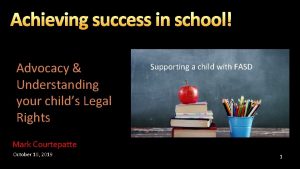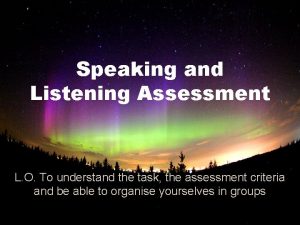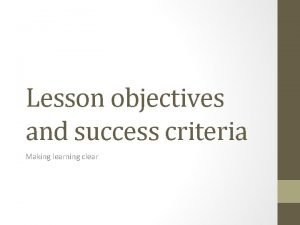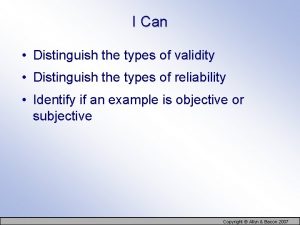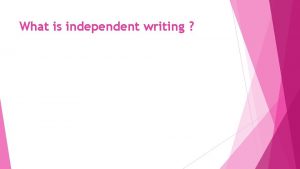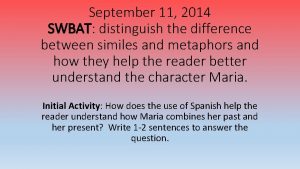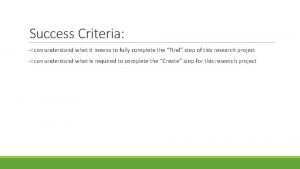Success Criteria 1 I can distinguish the difference



















- Slides: 19

Success Criteria: 1. I can distinguish the difference between hearing and listening 1. I can utilize the steps of the listening process to appropriately respond to a communication

TEKS: ▪ (1)(G): “Identify the components of the listening process. ”

Objective: Student Will Be Able To: Demonstrate their knowledge of listening skills to complete an activity.

“We have two ears and one mouth so that we can listen twice as much as we speak. ” - Epictetus

Listening: It is a physical and psychological process that involves choosing to listen, understanding, and responding to symbolic messages from others. Open your ears!!!

4 Kinds of Listening: ● Deliberative: listening to understand, analyze, and evaluate. Trying to accept or reject a persons view. ● Ex: A debate ● Empathic: listening to understand, participate in, and enhance a relationship ● Ex: Counselors and Therapists use this

● Critical: listening to comprehend ideas and information in order to achieve a specific purpose or goal ● Ex: Involves a problem, decision making ● Appreciative: listening to enjoy a speaker’s message or a performance on an artistic level ● Ex: Music, Poetry, Words of a great leader

The 3 Characteristics of Listening: ● Active: �You participate, listen attentively, and provide feedback �Strive to understand & remember messages

● Passive: �Listener doesn’t actively participate and think they can absorb information but not contribute �They place responsibility of communication on the speaker

● Impatient: �Short bursts of active listening is interrupted by noise/distractions �They intend (usually) to pay attention, but allow their minds to wander

Factors that affect the listening process: ▪ Noise: Temporary distractions �Train, baby, loud car, sick, tired, etc. ▪ Barriers: BLOCKS listening & understanding �Unfamiliar language, biases, tuning out, stress, ignorance.

THINK, PAIR, SHARE ▪ A teacher must overcome the sound of a lawnmower while teaching. ▪ A loud radio is preventing a child from hearing his or her parent's instructions. ▪ A student dislikes a teacher and refuses to listen in class. ▪ A foreign exchange student does not understand the teacher's directions. ▪ A student has a cold and cannot concentrate on the lesson in class. ▪ A student stayed up watching television until 3 A. M. and is falling asleep in class.

Steps in the listening process: Acquiring/Hearing Step 1 The reception of sound

Steps in the listening process: * Your own needs, interests, attitudes, and knowledge affects your choice to pay attention Attending/Choosing Step 2

Steps in the listening process: Your knowledge, attitudes, values, beliefs, and self-concept influence your perception * Understanding Step 3

Steps in the listening process: You first respond emotionally, then intellectually * Responding Step 4

Memory: (The process of retaining or recalling information) ▪ Immediate Memory: �Recalling information for a brief period of time ▪ Short Term Memory: �Recalling information for carrying out a routine or daily task ▪ Long Term Memory: �Recalling information from past experience

7 Common Roadblocks to Listening: ▪ ▪ ▪ ▪ Tuning out dull topics Faking attention Yielding to distractions Criticizing delivery/physical appearance Jumping to conclusions Interrupting Overreacting to emotional words

Activity: Get in groups of 6 Telephone Game Objectives: To increase listening skills within the group. The Story Objectives: To enhance deliberative listening skills. The Wright Family Objectives: To increase critical listening skills.
 Difference of ratio and proportion
Difference of ratio and proportion Your child's success or lack of success
Your child's success or lack of success Your child's success or lack of success
Your child's success or lack of success Speaking and listening assessment
Speaking and listening assessment Process success criteria
Process success criteria Lesson objectives and success criteria
Lesson objectives and success criteria Example learning intentions
Example learning intentions Learning intentions and success criteria examples
Learning intentions and success criteria examples Shape poem success criteria
Shape poem success criteria Features of an acrostic poem
Features of an acrostic poem Calculating equivalent fractions
Calculating equivalent fractions Equivalent fraction of 6/8
Equivalent fraction of 6/8 Autobiography writing for class 7
Autobiography writing for class 7 What is a biography?
What is a biography? Success criteria for listening skills
Success criteria for listening skills Tally chart success criteria
Tally chart success criteria Tally chart success criteria
Tally chart success criteria Direct speech success criteria
Direct speech success criteria Ixv roman numerals
Ixv roman numerals Learning intentions and success criteria for mathematics
Learning intentions and success criteria for mathematics


